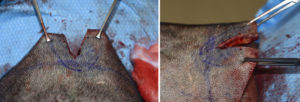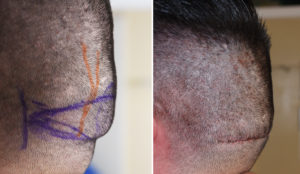Background: The back of the head is prone to multiple types of aesthetic concerns. Bony issues could include an isolated occipital knob, prominent nuchal ridges or areas of generalized flatness. Soft tissue issues are more limited and largely consist of soft tissues excesses known as horizontal scalp rolls. While often occurring as isolated issues, it is not rare to see various combinations of them occurring together,
One such occipital combination, seen exclusively in men in my experience, is a lower occipital bulge at the inferior end of the skull bone. It consists of a bony protrusion caused by the combination of an occipital knob and prominent nuchal ridges. Laying over it is a thick horizontal scalp roll. In treating this particular occipital deformity both must be reduced to flatten the transition from the back of the head into the upper neck.




Combining occipital knob skull reduction with overlying scalp roll excision provides the most complete flattening effect to the back of the head as is possible.
Case Highlights:
1) Some aesthetic occipital skull deformities have a combined bone and soft tissue component to them.
2) Lower end occipital bone and overlying scalp rolls can be treated through the same incisional approach.
3) Occipital scalp roll excision must take into consideration its thickness as well as the location of the greater occipital neuromuscular structures.
Dr. Barry Eppley
Indianapolis, Indiana





